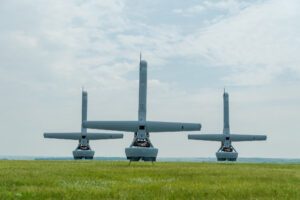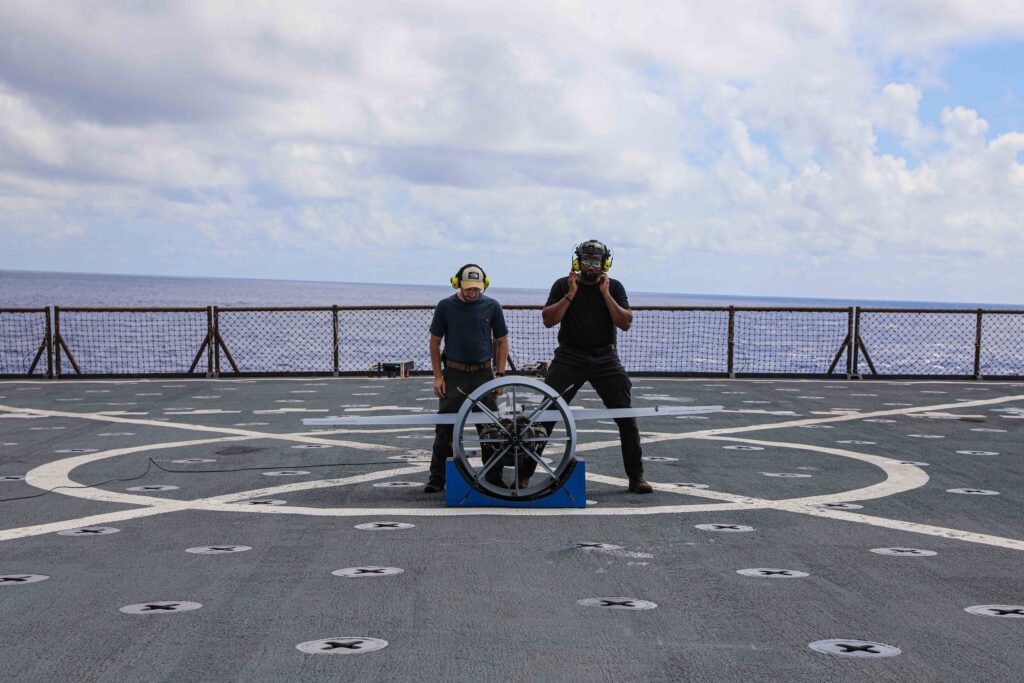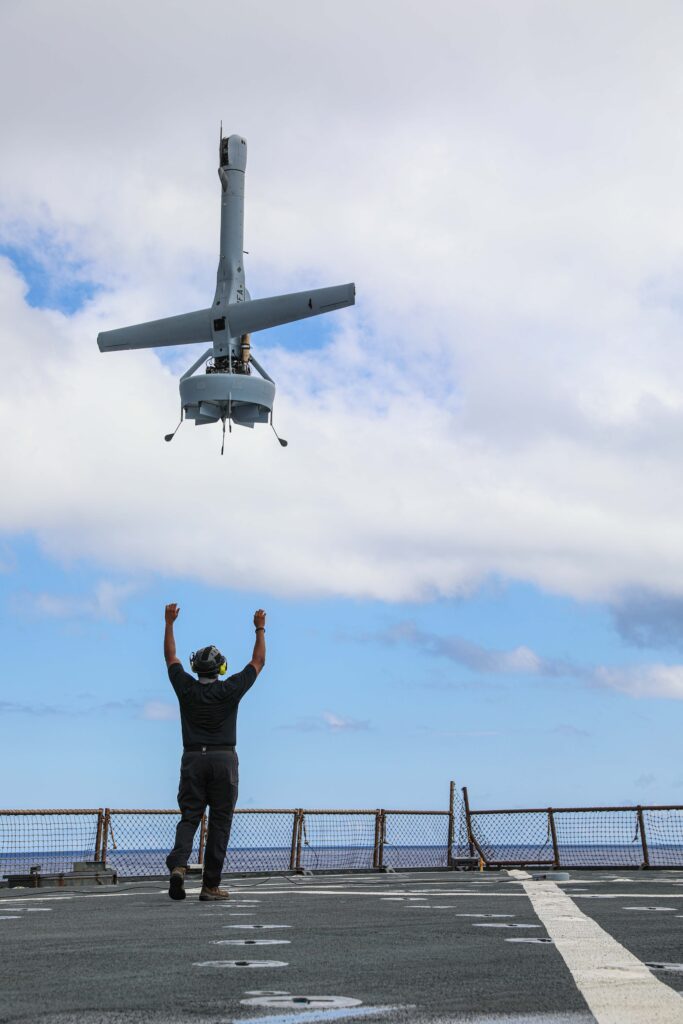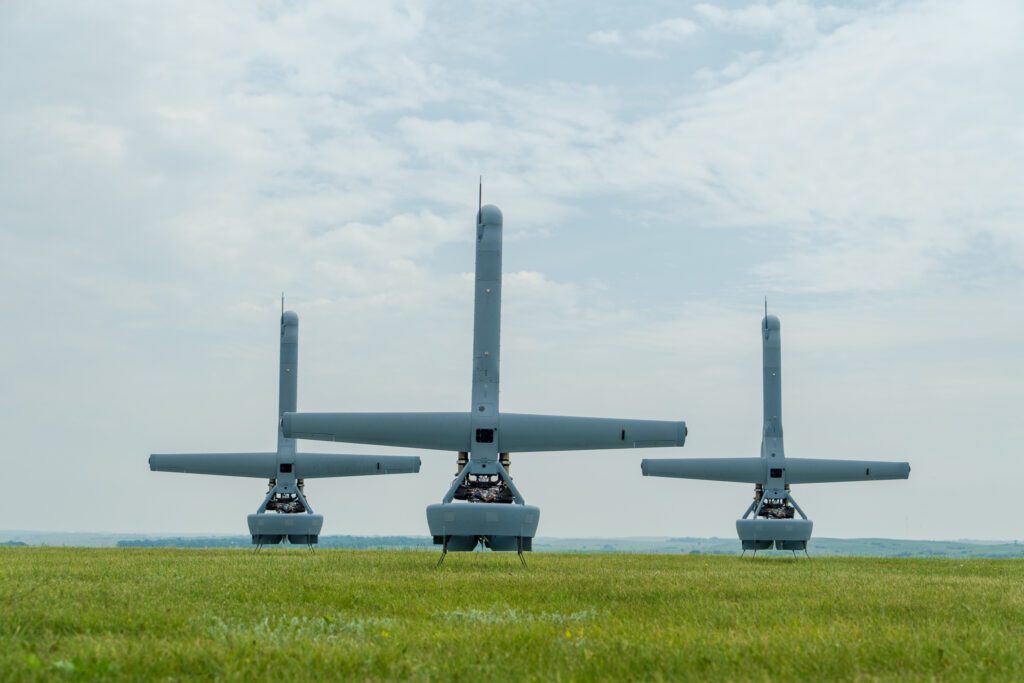[ad_1]
 Shield AI’s V-BAT Teams system allows autonomous operations under challenging conditions
Shield AI’s V-BAT Teams system allows autonomous operations under challenging conditions
By DRONELIFE Features Editor Jim Magill
As the U.S. Department of Defense searches for ways to use advanced technology to counter growing threats from international adversaries, a California robotics and software company has introduced a system that will allow warfighters to launch swarms of low-cost and easily replaceable drones to greatly expand a military unit’s surveillance capabilities across a broad expanse of territory.
Shield AI recently introduced its V-BAT Teams system, which uses artificial intelligence (AI) software to control multiple vertical takeoff and landing (VTOL) UAVs. These vehicles can operate autonomously even in hostile environments, where GPS and RF communication links are denied. At about nine feet long, with a nine-foot wing span and a weight of 125 pounds, the V-BAT vehicles are compact enough to be carried in the back of a truck and can be launched from the deck of a ship at sea.
Coupled with Shield AI’s propriety AI-powered piloting software, the V-BATs are designed “to operate in those denied environments where UAVs today cannot operate,” Shield AI’s director of engineering Willy Logan, said in an interview.

230717-N-ED646-2230- ATLANTIC OCEAN (July 17, 2023) Artur Vacshenko, left, and Jamal Ramsey, civilian contractors for the Department of Defense, prepare an unmanned aerial system for a test launch aboard the amphibious dock landing ship USS Carter Hall (LSD 50). The U.S. Navy and U.S. Marine Corps routinely participate in scheduled deployments to improve combined combat readiness, increase operational capacity, and strengthen relationships among allies and partners throughout the region. (U.S. Navy photo by Mass Communication Specialist 2nd Class Moises Sandoval)
“The key thing for V-BAT is that it can take off vertically, then it transitions to fixed flight, so it offers a lot of capability from logistics, in terms of being small,” Logan said. “Think about it in terms of the Navy, which needs to cover a lot of area — in the Pacific for example — without runways.”
Shield AI hopes that the military will adopt its technology as part of the Pentagon’s Replicator initiative, which calls for the deployment of thousands of low-cost and easy-to-replace autonomous vehicles over the next two years, as a counter measure to technologically sophisticated potential rivals such as China.
The company, which unveiled its V-BAT Teams product earlier this year, said it is ready to be deployed by U.S. military forces as early as 2024.

230717-N-ED646-2263- ATLANTIC OCEAN (July 17, 2023) Jamal Ramsey, a civilian contractor for the Department of Defense, launches an unmanned aerial system for a test flight aboard the amphibious dock landing ship USS Carter Hall (LSD 50). The U.S. Navy and U.S. Marine Corps routinely participate in scheduled deployments to improve combined combat readiness, increase operational capacity, and strengthen relationships among allies and partners throughout the region. (U.S. Navy photo by Mass Communication Specialist 2nd Class Moises Sandoval)
V-BAT vehicles are mobile and can be broken down and transported in molded plastic cases, manufactured by Pelican, that seal with an airtight and watertight gasket. They can be re-assembled and made ready to launch in about a half hour, Logan said.
The vehicle’s eight-bladed ducted fan allows it to take off vertically then switch to horizontal flight mode once airborne. It’s able to carry payloads of up to 25 pounds and achieve flight times of anywhere from eight to 10 hours depending on the vehicle’s payload configuration and fuel levels.
Logan said the V-BAT vehicles will be equipped with wide-area EO/IR (Electro-Optical/Infra-Red) cameras, plus an AIS [automatic identification system] and radar, giving them the capability to conduct long-range surveillance missions.
Shield AI’s Hivemind technology allows for the coordinated autonomous operation of a swarm of up to four drones. The company plans to double the software’s teaming ability every year for the next several years, controlling swarms of up to eight drones in 2025, and 16 vehicles in 2026.
The Hivemind software controls the flight of the swarm of drones, allowing it to operate in tandem without human intervention, even under conditions when communication with a human pilot is denied, such as when a hostile state actor disrupts the GPS and RF data links.
“You can provide a capability to operate when the GNSS (Global Navigation Satellite System) is contested or denied, like for example what’s happening in Ukraine now, where the Russians have set up lines of jammers,” Logan said. “They’re jamming airplanes, so the airplanes aren’t able to navigate, they basically fall out of the sky.”
The V-BAT teams’ first mission will be to conduct maritime-based searches over wide areas, such as the vast stretches of the eastern Pacific, where runways are few and far between. The initial batch of drones will not be armed, although the ability to arm the V-BAT exists and might be utilized in future deployments, Logan said.
“I think you can arm anything, so are we planning to deploy armed V-BATs? The answer is no, but is it something that’s in the future? Across the industry, I think the answer is yes,” he said.
Currently, the U.S. and other countries engaged in a vigorous debate over how much control should be given drones and robots outfitted with AI software that allows autonomous operations, especially whether they should be allowed to make targeting decisions against enemies, without humans in the loop.
“In my opinion, we’re a long way from a UAS targeting something without a human,” Logan said. “In general, what’s more likely is that a drone will go search for targets; it’ll identify the targets, it’ll locate the targets, and then it’ll ask a human if it should continue to engage the target.”
Shield AI was founded as a defense and AI technology startup by former-Navy Seal officer Brandon Tseng, his brother Ryan Tseng, and Andrew Reiter in San Diego, in 2015. While fighting in Afghanistan, Brandon Tseng hit on the idea of forming a company to develop a product that could be used to enter and search buildings, without exposing its human operators to unnecessary danger.
To that end, the company developed the Nova drone. In 2016, the U.S. Department of Defense issued the start-up company its first contract, and deployed the Nova product for reconnaissance and combat assistance missions in the Middle East theater of operations in 2018.
The company went on to develop Hivemind, an AI piloting software that can operate not only V-BAT vehicles but also larger unmanned aircraft. Shield AI has partnered with several manufacturers, including Kratos, to develop software stacks for their aircraft.
Read more:
 Jim Magill is a Houston-based writer with almost a quarter-century of experience covering technical and economic developments in the oil and gas industry. After retiring in December 2019 as a senior editor with S&P Global Platts, Jim began writing about emerging technologies, such as artificial intelligence, robots and drones, and the ways in which they’re contributing to our society. In addition to DroneLife, Jim is a contributor to Forbes.com and his work has appeared in the Houston Chronicle, U.S. News & World Report, and Unmanned Systems, a publication of the Association for Unmanned Vehicle Systems International.
Jim Magill is a Houston-based writer with almost a quarter-century of experience covering technical and economic developments in the oil and gas industry. After retiring in December 2019 as a senior editor with S&P Global Platts, Jim began writing about emerging technologies, such as artificial intelligence, robots and drones, and the ways in which they’re contributing to our society. In addition to DroneLife, Jim is a contributor to Forbes.com and his work has appeared in the Houston Chronicle, U.S. News & World Report, and Unmanned Systems, a publication of the Association for Unmanned Vehicle Systems International.
Miriam McNabb is the Editor-in-Chief of DRONELIFE and CEO of JobForDrones, a professional drone services marketplace, and a fascinated observer of the emerging drone industry and the regulatory environment for drones. Miriam has penned over 3,000 articles focused on the commercial drone space and is an international speaker and recognized figure in the industry. Miriam has a degree from the University of Chicago and over 20 years of experience in high tech sales and marketing for new technologies.
For drone industry consulting or writing, Email Miriam.
TWITTER:@spaldingbarker
Subscribe to DroneLife here.
[ad_2]

